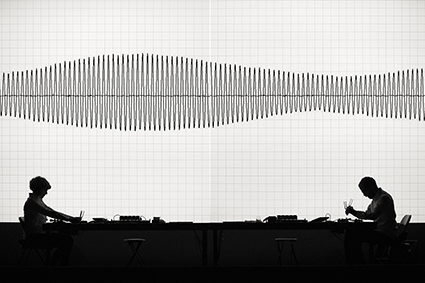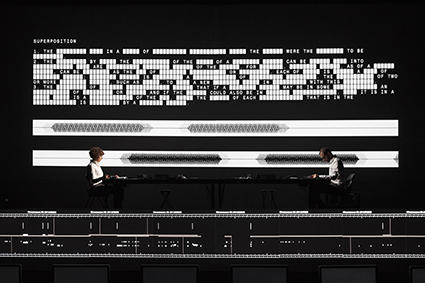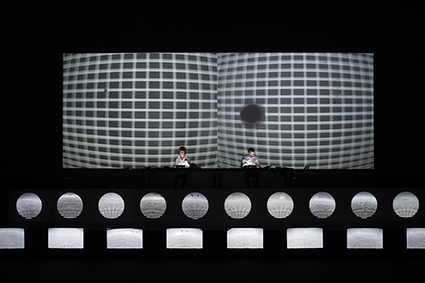The force inhabits you
Lauren Carroll Harris: Review, Ryoji Ikeda, Superposition

Ryoji Ikeda, superposition, 2015, Carriageworks, Sydney
Image Zan Wimberley
Ryoji Ikeda, superposition, 2015, Carriageworks, Sydney
It is film history legend that the release of Star Wars (1977, now known as Star Wars: Episode IV—A New Hope) changed the course of cinema sound. Director George Lucas and his gun sound design team used the just-emerged technology of Dolby Stereo Sound to hide a series of low frequency waves that accompanied the Star Destroyer and the Death Star at a pitch that the human ear could not detect but that the body could feel. As the monster spaceships passed across the top of the screen, the bass frequency produced a rumble that gently but tangibly shook the plush cinema seats and rang through the viewers’ bodies. It was a Freudishly evil move. The force literally inhabited people: the work was felt in the body rather than understood with the intellect.
I couldn’t help but think of this while experiencing Japanese artist Ryoji Ikeda’s newest work, Superposition, at Sydney’s Carriageworks. A similarly advanced space-time force invaded those who ventured into this vastly imaginative and precisely realised video, sound and installation work, currently touring the world like a music gig. An artwork about data sounds dry, but Ikeda has created another work of extreme coolness and affective power.
Unlike Spectra—the sculptural tower of white light that punctured Hobart’s skies in 2013—Superposition is the first Ikeda work I’ve experienced that occupies a traditional theatrical set-up. Rather than being plunged into a big space to move through, we face a series of onstage screens from the comfort of seats. It’s also the first work of Ikeda’s that includes performers: a hyper-focused woman and man reading streams of data and inputting them to the work in real time. Not only does their presence bring the work into the realm of time-based performance, it gives us a human element and a start-point to relate to in the data stream.
For an hour, the duo taps out messages through an array of Morse Code machines, tuning forks and microfiche scanners, all of which are monitored by Go-Pros fixed to the stage and beaming live onscreen. In this way, the work quite literally realises the 21st century experience of information overload, a return from cliché to truth. Each new data source has a corresponding effect: every movement by a performer produces a sound and image. In this way, Ikeda’s work reminded me of a basic law of physics—that every action has an equal and opposite reaction. This returns us to the work’s self-professed mandate of reflecting on how “we understand the reality of nature on an atomic scale…inspired by the mathematical notions of quantum mechanics.”

Ryoji Ikeda, superposition, 2015, Carriageworks, Sydney
Image Zan Wimberley
Ryoji Ikeda, superposition, 2015, Carriageworks, Sydney
Being conceived at the art-science nexus, Superposition also involves a crack team of offstage specialists involved in programming, graphics, computer systems and optical devices. Every little bit of the work–every little bit—is so fully realised, even the musical output could stand alone as a soundtrack, and was in fact separately commissioned by the Festival d’Automne in Paris.
But thankfully, Ikeda is smart enough not to prize the parts over the whole. There is too much to take in, but I suspect that is his intent: to drive us back to the realm of experience rather than analysis. He has developed a type of deeply conceptual art that embraces rather than rejects the aesthetic. While Superposition is mostly anchored in a Matrix-like monochrome palette, the artist understands the potency of an occasional thunderbolt of colour. Where beauty and sublimity have been central concerns of art since forever, Ikeda immerses us in a digital sublime of ones and zeros, bridging the massive with the minute.
Under Lisa Havilah’s directorship, Carriageworks continues to program works of the moment that have wide appeal. Audiences come to an understanding of a work through many factors: personal history, ideology, taste, other works, formal education and instruction in how to read an artwork. The scope of Superposition is so far-reaching that every viewer can craft their own set of associations in endless ribbons of interpretation. Given the movie theatre set-up, the work spoke to me cinematically, and as it devolved into something more abstract, I felt hurled into the final strobing third of Stanley Kubrick’s 2001: A Space Odyssey (1968), the trippiest part in which astronaut Dave is hurtled through space and time towards the star child and his own old-age.
But Ikeda’s creations are so much more than visual and aural representations of data dreams and physics and quantum mechanics. His are works to be soaked in and soaked up: truly immersive and experiential, even within the walls of a traditional stage space. In an age where much conceptual art must be clinically understood—dissected rather than felt—Ryoji Ikeda brings us back to the realm of affect and dreaming.

Ryoji Ikeda, superposition, 2015, Carriageworks, Sydney
Image Zan Wimberley
Ryoji Ikeda, superposition, 2015, Carriageworks, Sydney
Ryoji Ikeda, Superposition, Carriageworks, Sydney, Sept 23-26
RealTime issue #130 Dec-Jan 2015 pg. 29






